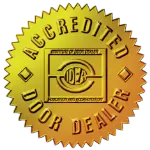The garage door is the largest and heaviest moving object in most homes. Sometimes these doors can weigh in excess of 400 pounds. They hang over your head, your children’s heads, and your expensive automobiles, yet most people never take time to make sure their garage door and opener are working properly and safely.
Automatic garage doors are a safe, reliable convenience, but poor maintenance and carelessness with these doors can result in tragedy. According to the Consumer Products Safety Commission, at least 68 children have died in accidents from electronically operated garage doors since 1973. In 1994 alone, the CPSC estimated there were approximately 20,000 injuries related to garage doors and openers.
Many of these injuries and deaths could have been avoided if the following list of do’s and don’ts had been followed.
DON’TS
Don’t play with the garage door, door hardware, or opener.
Don’t adjust or replace door springs, cables or other door hardware yourself.
Don’t open or close your automatic garage door if it is out of your sight.
DO’S
Respect the power of your garage door and opener. They are potentially dangerous.
Remove all ropes, hooks, and other projections from your garage door if you have a garage door opener. These items can catch on a child’s clothing or pet’s collar, causing serious injury or even death.
Disable the lock on the garage door if there is a garage door opener. This will help prevent damage or injury caused by someone accidentally locking the door and trying to operate the automatic opener.
Keep all fingers and hands away from the garage door section joints when lifting or lowering the garage door, or while the door is moving to help prevent serious injury to fingers or hands.
Read your garage door and opener owner’s manuals and file them for future reference.
Know how to disengage your automatic garage door opener in case of an emergency.
Wait until the garage door has stopped moving before proceeding into or out of the garage.
Be sure all the proper warning labels are installed in their correct location.
Place all door opener controls out of the reach of children. The wall-mounted push button should be at least 5′ from the floor and children should not have access to the hand held remotes. Supervise children around your automatic garage door and teach them that it is not a toy.
SAFETY TIP: Children playing with the wall control panels of your automatic garage door opener can lead to accidents that might cause either personal injury or property damage. Test your door opener’s reverse mechanism every month by placing a 2×4 laid flat on the floor underneath the middle of the garage door. Operate the door with the opener and when the door comes in contact with the 2×4 it should reverse within 2 seconds and go back up. If your door does not reverse, refer to the owner’s manual for proper adjustment or call a professional to have it checked out.
Check the up and down force adjustments monthly. Try stopping the door with your hands when it is going down, the door should reverse fairly easily. Likewise, try stopping the door when it is going up with your hands, it should stop fairly easily. If it doesn’t do either one fairly easily, refer to your owner’s manual for instructions or have it checked by a professional.
SAFETY TIP: A faulty or improperly adjusted reversing mechanism on your garage door opener could cause damage to your car or even injure a child or pet that inadvertently gets caught in the way of the closing door. All garage door openers manufactured after 1991 are required to have a reversing mechanism.
Replace your pre-1993 garage door opener, if you have one, with a newer one that has non-contact infrared safety sensors and is U.L. listed. Make sure that if your garage door opener is already equipped with infrared safety sensors (eye beams) that they are mounted 4″-6″ from the floor and that they are working properly.
SAFETY TIP: Reversing mechanisms activated by contact can prevent most potential damage or injuries caused by a garage door closing automatically. Properly working “photo eyes” now offer an added safety guard but, if bumped or jarred in any way, photo eyes may be disabled. Required on all garage door openers manufactured and installed after 1993, photo eyes are connected to the bottom of the track and reverse the door when an infrared beam is broken. Safety is improved because nothing actually has to make contact with the door before it reverses.
Check your garage door’s balance regularly. When the door is closed disengage the opener. The door should stay on the floor. Raise the door approximately 1/2 way up slowly and stop it. It may move slightly up or down but it should settle in one place about midway up. Slowly raise the door all the way up and the bottom of the door should stay even or just slightly above the frame of the garage door opening. If your door fails this test please have it adjusted by a professional. Garage door springs are very powerful and dangerous.
SAFETY TIP: A garage door that does not go up and down smoothly when manually operated probably has a spring system that is out of balance or a problem with the track and roller system that could cause premature wear and tear on your door’s hardware. Depending on how worn the springs and rollers are, your door may need to be adjusted or replaced. If your door fails this test please have it adjusted or serviced by a professional. Garage door springs are very powerful and dangerous.
Check your garage door’s extension (stretch) springs. They should have safety containment cables installed.
SAFETY TIP: Check your door carefully to make sure the springs use a safety containment cable. If a spring should break, safety containment cables prevent it from snapping free and causing damage or injury.
Check the other garage door hardware regularly and have any worn or broken parts replaced by a professional immediately.
SAFETY TIP: Beware of old springs, keep in mind that garage door springs are actually tightly wound and under high tension, and this is why they can be the source of accidents. A breaking spring could lash out and strike property or people. If you have an older garage door, be certain your springs are inspected and replaced by a professional installer and replace if needed. If your door has two springs, replace both, even if one is not broken. This will not only prevent any damage caused by the breaking of the second spring, but also keep your door working efficiently.
Keep up with routine maintenance and lubrication.
SAFETY TIP: Your garage door is probably the largest moving part in your home and is typically used every day. Over time, parts can wear out and break, creating potential safety problems. Although there is some light maintenance and inspections you can perform yourself you should have your garage door professionally serviced at least once a year to ensure maximum safety and increase the life of your door.
This important information is provided by the U.S. Consumer Product Safety Commission, the National Safety Council and the Industry Coalition for Automatic Garage Door Opener Safety.





